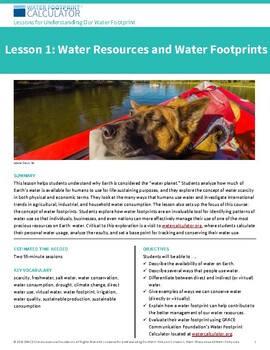Middle School — Lesson 1: Water Resources and Water Footprints
- PDF
Description
This lesson gives students an in-depth understanding of key water issues. They learn about water resources and water footprints, then use the Water Footprint Calculator to analyze their direct and virtual water consumption. Students get a foundation of knowledge and learn why they should care about protecting water resources, which makes it easier for them to make a fundamental shift in attitude about their water use. Designed for middle school – lower secondary level, ages 11 to 14 – the lessons can be easily adapted to the elementary level.
This free PDF file download includes the complete Lesson 1 with all supplementary material. Included in this download:
Lesson Plan 1
- Lesson Plan
Supplements
Session 1: How Do We Use Water?
- Water Resources and Water Footprints Presentation
- Water Resources and Water Footprints Teacher’s Notes
Session 2: How Do I Use Water?
- My Water Footprint Stats Student Worksheet
- My Water Footprint Stats Sample Answers (For Teachers)
- Basic Rubric
- Participation Checklist
To download the other two free middle school lesson plans and learn more about “Lessons for Understanding Our Water Footprint,” go to Watercalculator.org:
Lesson 2: My Water Footprint: https://www.watercalculator.org/resource/middle-school-lessons/#MyWaterFootprint
Lesson 3: The Value of a Water Footprint: https://www.watercalculator.org/resource/middle-school-lessons/#ValueWaterFootprint
Standards alignment with the Texas Essential Knowledge and Skills (TEKS); Common Core State Standards (CCSS) for ELA/Literacy and Mathematics; Next Generation Science Standards (NGSS); and the Cloud Education for Sustainability (EFS) Standards & Performance Indicators.





